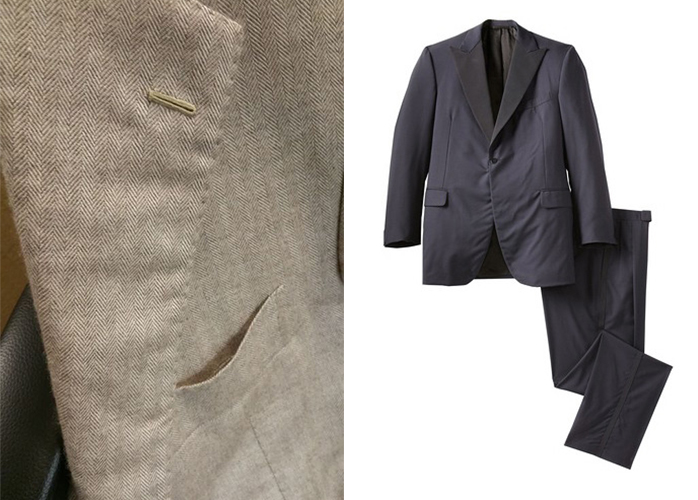
Krishna from Columbus writes: I’m currently rebuilding my wardrobe and buying some higher-quality pieces. Since these suits will be a bit expensive for me, I’d like to know how to best care for them. How do I go about finding a reliable dry cleaner? What things should I be doing to make sure my clothes last?
Here’s the short answer: get a garment brush and some appropriate hangers, do some things to prevent clothes moths from invading your home, dry clean infrequently, and figure out the proper care routine given how your clothes are made.
Here’s the longer answer: To figure out how to take care of your clothes, it helps to think about how they’re made and how dry cleaning is done. When you buy high-end tailored clothing, much of what you’re paying for is the careful shaping that’s put into the garment. Suits and sport coats are made from a combination of canvas, haircloth, padding, and skillful stitching, which turns a two-dimensional piece of fabric into a three-dimensional form. Once the garment is sewn, it’s shaped through heat, pressure, and steam. At a factory, this is done through a machine. In a tailor’s workshop, it’s done by hand using a hot and heavy iron.

Let’s take a look at what we mean by shaping. In the photos above, taken from Jeffery Diduch’s excellent guide on touching up your suit without wrecking it, you can see how much shaping is in the garment. The chest is nicely round; the sleeves conical. There’s not a dent, wrinkle, or ripple anywhere. This shaping is partly responsible for why tailored jackets are so flattering. When made well, they have a flattering V-shaped figure, which is possible through stitching and ironwork. You can’t get that silhouette out of a dress shirt.
Over time, this shaping will naturally fall out, and the garment will have to be pressed into shape again (I find the sleeves are often the first to go, especially if you have a cramped closet). At home, it’s pretty easy to press trousers. All you need is an ironing board, a regular iron, a water spray bottle, and a pressing cloth (in a pinch, a pillowcase will do). You can find online tutorials for how to press trousers by watching these videos from the British menswear retailer TM Lewin or bespoke tailors Antonio Liverano, Patrick Chu, Richard Anderson, and Dylan Chong.
Pressing a jacket, on the other hand, is a different matter. Knowing how to press a jacket well requires time, skill, experience, and professional training. You also need the right equipment, such as a sleeve board. I’ve embedded a video above showing how Liverano & Liverano do it at their workshop in Florence, Italy, but only to show the skill involved. This is not something I recommend trying at home unless you want to become a tailor.

Once you see the shaping that goes into a high-end tailored garment, it’s easier to appreciate a couple of things.
First, you want to avoid garment steamers. Companies sell garment steamers on the promise that they’ll remove wrinkles. They will, but they also remove shaping. Remember that a garment’s shape is made using a combination of heat, pressure, and steam. It’s like using a curling iron on your hair. If you run steam through a garment without applying pressure, the fibers relax, and the garment goes limp (much like how a woman’s hairdo will go limp if you run steam through it). In rare cases, a garment steamer can cause a fused garment to delaminate. In more common instances, it will cause the seams and edges to pucker (see photos above). Since a tailored garment is made from various layers of material — the shell, canvas, haircloth, padding, and stitching — forcing steam into the garment can cause the fibers to expand and contract at different rates. Over at StyleForum, you can find threads where people have asked about their ruined suits, only to find it’s because of their steamer. A tailor can sometimes fix a puckered lapel with a good hand press. However, sometimes the damage is permanent.
If you’re worried about wrinkles, buy garments that don’t wrinkle easily in the first place. High twist wools are naturally wrinkle-resistant, and heavier fabrics will rumple more than they wrinkle. Aim for materials that are at least 10oz (midweight fabrics between 12oz and 14oz are better). Wrinkles should fall out of these garments if you hang them up for a few days. If you have to use a steamer, use it judiciously and stay away from the seams. Steaming the back of a jacket (lightly) can be OK. Pushing a ton of steam through the lapels and chest is a bad idea.
Second, think about how dry cleaning is done. Most dry cleaners don’t clean their own clothes. Many are just drop-off locations for a mass-cleaning facility outside the city’s limits. For every one of these facilities, known as a central plant, there might be five to twenty “satellite” shops scattered throughout various neighborhoods. These shops compete on price, service, and turnaround time, but the cleaning quality is often poor (largely because the price has been driven so low through competition). It’s not uncommon for mass cleaning facilities to reuse their cleaning agents, which can deposit dirt from previous loads onto your clothes. Many also don’t separate stains and pre-treat them accordingly. And almost none of them will have something on-site to help shape a garment. The high-end pressing machines you find in suit factories are too expensive; skilled people who know how to press a suit jacket properly are in short supply. Instead, many of these cleaning plants will just put a suit jacket on a dummy and blow hot steam throughout it, which is terrible for the reasons mentioned above. Or they’ll put them through a heavy Hoffman press, which can crush a finely tailored jacket’s shoulders, sleeves, and lapels.

So, how should you care for your garments?
Get a Garment Brush: A garment brush will reduce the number of times you have to take your clothes to a dry cleaner. To use one, hold your jacket by placing your hand under the shoulder pad and brush downwards on the garment. Alternatively, you can set your garment on a table and gently brush it along the nap of the fabric (if it runs in one direction). Kent in England makes some lovely garment brushes that will last you a lifetime. The CC20 is a two-sided brush with different levels of stiffness. The CP6 is designed for softer fabrics such as woven cashmere. I have both and, to be honest, don’t think they differ too much. Get one that appeals to you and adjust your brushing technique accordingly. On a softer garment, be gentler; on a hardy tweed, you can be rougher. Never brush so hard that you’re taking the pile off a fabric. A garment brush will knock some of the superficial dust from your garments between wearings, and it’ll restore the nap on woolens if you press your own trousers.
Get Good Garment Hangers: Remember that tailoring is all about shape, and you need to find ways to preserve that shape. Quality garment hangers do this by supporting your jacket through the shoulders. An ideal hanger will have wide, flared shoulders that slightly bend forward, mimicking your natural posture (which your garment will have been built for). It should also have a rounded neck, as square necks can stretch out your jacket’s collar. You can find quality hangers through The Hanger Project or, more affordably, The Container Store.
Protect Against Moths: When storing suits away for a season, dry clean them first to ensure they’re free of moth eggs. You’ll also want to keep them in zippered garment bags made from pure cotton, not plastic (The Container Store sells them for $20 apiece). Throw some aromatic things in your closet to deter moths from going in. Cedar blocks and lavender sachets work well, but don’t let them touch your clothes, as they can leave behind oils. Additionally, and unfortunately, proper moth prevention involves regular cleaning. Vacuum the back of your closet and wipe down the shelves at least once a year (ideally before April, when moths eggs start to hatch). Spray the floorboards with Cedarcide, safe for pets but deadly for insects. We have more moth-prevention tips in this interview with Camille Myers Breeze, a museum textile conservator.
Find a Reliable Dry Cleaner: If you see a small shop with no machines except for a conveyer behind the counter, and they charge $8 to clean a two-piece suit with next-day service, you’re likely working with one of these drop-off locations for a central plant. It’s also likely that your clothes are not getting that much attention.
Instead, try to find a package plant, which is a dry cleaning business with its own equipment on-site. Ask them how they treat different types of stains (e.g., oil- versus water-based stains). Ask if they use freshly purified or freshly distilled fluids with every run. Check how they press garments — by hand with heavy iron or by machine using hot steam? When you get your garments back, pay attention to the cleanliness of the seams and edges, the shape of the garments, and the feel of the fabric. Do they feel soft, as you remember them, or a bit stiff? Many cleaners will use what’s known in the trade as sizing, which stiffens a fabric a bit so that it’s easier to press. Great for efficiency, but bad if you want to maintain the soft hand and lovely nap on something such as high-quality woolen flannel.
If you can’t find a reliable dry cleaner near you, I recommend sending things to Rave FabriCARE in Scottsdale, Arizona. They’re a full-service package plant and the best dry cleaner I know of in the United States. Along with cleaning everything themselves and pressing garments by hand, they offer a gentler sponge-and-press service for people who don’t want to dry clean.
The tips above are the Gold Standard of care for Gold Standard suits. If you buy bespoke suits from Savile Row, you’ll want to follow this guide closely because you’ve paid a lot of money for that careful tailoring and shaping. However, if you buy more affordably priced, factory-made suits, they may not have that same shaping. In those cases, it may not be worth sending things out to a high-end dry cleaner regularly, as the cost of service can eventually exceed the price of the garment itself. A steamer might pucker your suit, but you can use one judiciously and take comfort in knowing that few people notice these small details. The best care practices will be those that make the most sense for your wardrobe, budget, and service options around you.
(Photos via Alex Simpson, Jeffery Diduch, and The Armoury)
The post Q & Answer: How Should I Take Care Of My Suit? appeared first on Put This On.
